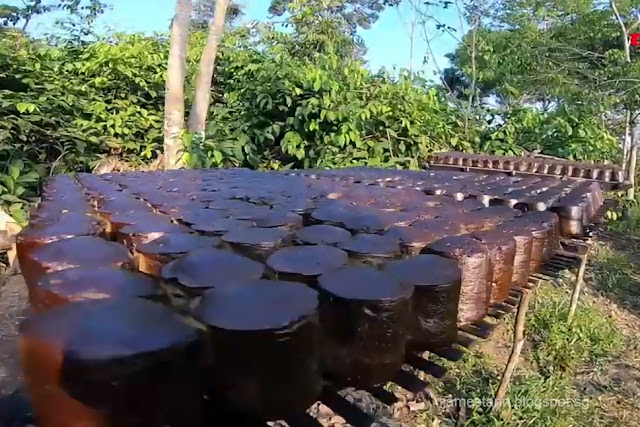Thursday, October 17, 2019
The arduous life of a gambier coolie in early Singapore
If you had been following my blog, you may come to realise that gambier is often mentioned in many articles. Why this fixation with gambier?
Was it because my forebears were gambier farmers? Was it because the Hillview region and Princess Elizabeth area, on which my blog is based, were all gambier farms in the past? Was it because most people today don't know about it? In a way, perhaps it's all these reasons. |
| A gambier processing facility, called a Bangsal, in early Singapore. Note the coolies bringing in their harvest of leaves. (Photo source: National Archives Singapore) |
My great-great grandfather, Mr Chua Chin Huat, a Teochew Catholic, started his gambier farm in the Chua Chu Kang area beside the Peng Siang River in the 1830s. He was the Kangchu and the farmland was called Chua Chu Kang, named after him. By 1855, it was recorded that he had 650,000 gambier plants and 105,000 vines of pepper on his farm.
Records also showed that he had to pay quit rent to the municipal government for 30 plots on his farm. This would imply that he might have up to 30 tenanted farmers, or coolies, working for him on his land. The coolies and tenant farmers lived a hard and impoverished life, some of whom were indentured labourers.
Gambir and pepper agriculture died out in Singapore by the end of the 19th century. Surprisingly, gambier farming still exist in neighbouring Indonesia but little in the way of life has changed for the gambier farmers today.
 |
| The flower of the Gambier plant, Uncaria Gambir. |
 |
| The leaves are where the gambier extract are derived. |
What is gambier?
Gambier is an extract from the leaves of a plant, Uncaria Gambir, which is only found in the Malay Archipelago. The processed extract was long used by the Chinese for medicines and for chewing the betel nut quid. Later, it was discovered that the tannic acid from the gambier plant was an excellent agent for use in tanning leather, and was very much cheaper than using European oak tannins. This discovery caused a boom in the the gambier trade with an insatiable demand from Europe. Today, gambier extract is used mainly for cosmetics and dyeing.
 |
| Raw gambier extract. Gambier plants can been in the background. |
Gambier was traditionally carried out on a shift agriculture basis. When the soil had been exhausted of its nutrients, the farmers will move to a new plot to grow new gambier plants. The old plots would be used for growing pepper, with the old processed gambier leaves used as fertiliser.
Gambier is an astringent plant, which means that its potency will diminish quickly and has to be processed immediately on harvesting.
The following photos show how gambier is extracted and processed. It is still done by small farm holders through a long laborious method that has hardly changed since the 19th century.
 |
| The gambier leaves are harvested when is it between 4-6 months old. |
 |
| The gambier leaves are harvested and brought directly to the bangsal for processing. Note the similarity to the 19th century picture, at top, and the bamboo basket which has not changed in design. |
 |
| The gambier leaves are stuffed tightly into a wicker basket. |
 |
 |
| The entire basket of gambir leaves is boiled until the leaves turns brown. |
 |
| The cooked leaves are removed from the boil and tied into a bundle for the next stage. |
 |
| The hot bundle is placed into a press to extract the juice from the leaves. Once the juice is extracted, the leaves are re-boil for a second pressing. |
 |
| Today, a hydraulic press is used. The only advance since the early days. Previously, heavy rocks were placed on top and pressure was applied manually with a long pole. |
 |
| The gambir extract is collected and poured out into trays and left to dry. |
 |
| When the extract becomes a semi-solid compound, it is formed into bricks. |
 |
| The bricks are left to dry in the sun. This is the end of the raw process. From these dried bricks, it is sold to be further processed into other products. |
Following are some vintage photographs of actual gambier farms taken in the 1890s.
 |
| Coolies gathering the gambier leaves into baskets. |
 |
| Gambier processing 'Bangsal' or processing shed. |
 |
| Inside the processing bangsal where the gambier leaves are cooked and pressed. |
Subscribe to:
Post Comments (Atom)


No comments:
Post a Comment